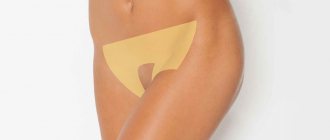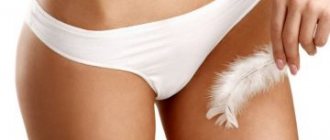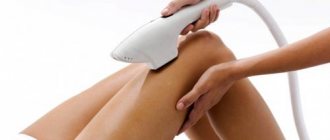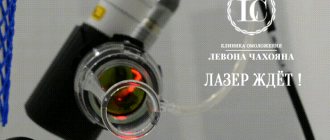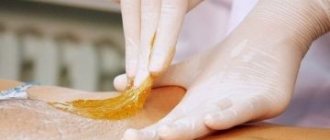The choice between photoepilation and laser hair removal often leads to a dead end - the short descriptions of the techniques are similar, it is difficult to make a choice for a simple reason - the meaning of the operation of the devices is incorrectly presented. Both methods are based on the use of a light beam, but in the first case it comes from high-energy lamps, and in the second it comes from laser radiation.
Let's look at the difference between photoepilation and laser hair removal, what principle they work on, the advantages, disadvantages and features of the technologies.
What is laser hair removal
Laser hair removal is considered a more progressive method of hair removal. It works on the same principle as photoepilation, but differs in the local spectrum of action. The energy of a narrow laser beam extends to an area of the body and affects a specific type of hair - even if its color matches the color of the skin. Heating the follicle leads to the absorption of melanin, after which the hair’s nutrition stops ().
One pulse takes a fraction of a second, and its effect extends over an area from 3 to 10 square meters. cm. The laser action covers a smaller area, so the laser therapy session lasts longer. However, the positive effect is not visible immediately, but after several weeks. This is normal - the intervals between sessions at the initial stage are 1-2 months. In the future, they are increased at the discretion of the cosmetologist.
Flaws:
high price;
side effects in the form of an unpleasant tingling sensation;
possibility of burns;
need for pain relief;
no effect on light, gray hair;
allergic reactions are possible;
Pigmentation is possible on tanned skin.
Most modern lasers have all the advantages of photoepilation, but there are fewer disadvantages, including higher efficiency when epilating light hair, and a significantly lower likelihood of burns ().
Video: how to choose the right home photoepilator
Photoepilation is a relatively quick and painless way to combat facial and body hair, which has a minimum of contraindications and side effects. Proper preparation for the procedure and following the doctor’s recommendations after it will allow you to forget about this delicate problem for a long time, giving you smooth and delicate skin.
- Author: woman
Rate this article:
- 5
- 4
- 3
- 2
- 1
(0 votes, average: 0 out of 5)
Share with your friends!
List of contraindications
Both procedures are considered safe in the absence of systemic diseases.
Contraindications:
- skin damage, inflammation;
- chronic skin diseases (eczema, psoriasis, dermatitis, etc.);
- benign, malignant neoplasms;
- epilepsy, diabetes mellitus;
- tuberculosis in active remission;
- period of pregnancy, lactation (breastfeeding);
- phlebeurysm;
- chronic heart and vascular diseases;
- treatment with tetracycline antibiotics;
- presence of electronic devices in the body;
- congenital sensitivity, allergy to light;
- rehabilitation period after surgery;
- a number of immune diseases;
- Age restrictions (persons under 16 years old).
Before hair removal, you should consult with your doctor and cosmetologist.
Features of photoepilation
Photoepilation is divided into four types ():
- IPL hair removal.
Impact on melanin and hair follicles with a broadband pulsed light source. The technology is used in home epilators. Most effective for light skin and dark hair. - Epilation ELOS.
A combination of laser technology and photoepilation. Highly effective for dark and fair skin. - LHE hair removal.
The procedure is based on the thermal effect on the structure of the follicle. A gentle method, but requiring a large number of sessions. Protective gels and anesthesia are not used, because... The luminous flux density is quite low.
Stages of implementation:
- The cosmetologist collects anamnesis and examines the epilation area. Gives recommendations for care, talks about the technique, the result after the session.
- The client puts on safety glasses. The skin is cleansed. If the pain threshold is low, an anesthetic gel is applied.
- The tip of the maniple makes flashes over an area of vegetation. During the session there is no visible effect, hairs do not fall out. There may be a slight burning sensation.
- The session takes from 5-7 minutes to 35-50 depending on the area of hair removal. Upon completion, a restorative, soothing agent can be applied to the skin.
IPL hair removal. The essence of the technique, indications and contraindications.
IPL photoepilation is an innovative technology for hair removal from almost any part of the body. It is based on the property of broadband light to penetrate the skin and have a selective effect on the treated area. In this case, the point of application is the hair pigment – melanin. As a result of light exposure, the production of collagen in the skin is also stimulated, thereby increasing its elasticity.
IPL hair removal is one of the safest and most painless hair removal methods. This is due to the short-term effect of the light flux on the skin and individual selection of the power and duration of irradiation, taking into account the skin phototype and its sensitivity. What is she?
This photoepilation method is based on the use of IPL systems. In them, the light source is a flash lamp, which generates high-intensity incoherent light radiation with wavelengths in the range of 500-1200 nm.
During the procedure, the energy of the light wave is absorbed by the hair pigment melanin. It is he who is able to absorb pulsating light. After this, the light energy is transformed into heat, heating the hair follicle and destroying the vascular papilla that feeds the hair. As a result, IPL photoepilation leads to irreversible destruction of the hair follicle by light. Hair removal does not occur immediately, but over a certain period of time - approximately 5-7 days. The area where the hair follicle is located is gradually filled with connective tissue.
History of the procedure
IPL photoepilation was first proposed by the Swedish physician and engineer Morgan Gustafsson at a dermatology convention held annually in Stockholm. After 5 years, Lumenis Ltd. A patent for the technology was issued, after which mass production of photoepilation devices began. In 2000, the FDA (Food and Drug Administration) recognized IPL as an effective hair removal technology. A year later, they began to use it for the purpose of photorejuvenation. Soon the method began to be used to eliminate age spots and vascular spots.
How it works
As a result of the absorption of light energy, various reactions are triggered in tissues, the main one of which is thermal. After absorbing a large amount of energy, the tissues are heated to a temperature at which their destruction, or thermolysis, begins. During ipl photoepilation, this process is triggered by exposure to light energy, which is why it is called photothermolysis. Light of different wavelengths is absorbed differently by tissues depending on their color, so the effectiveness of photoepilation is largely determined by the presence of the dark pigment melanin in the hair and follicles and the correct selection of light wave parameters. During ipl hair removal, waves of a length that is optimally absorbed by melanin and minimally absorbed by other pigments present in the skin are used. Photothermolysis of the hair follicle with minimal damage to other tissues is called selective.
In cases where, under the influence of selective thermolysis, all the cells of the hair follicle responsible for hair growth die, hair growth stops. If the follicle is simply damaged, the hair growth cycle is disrupted, its thickness and degree of pigmentation are reduced, but it continues to grow.
Solving the Selectivity Problem
Since melanin is found not only in hair and hair follicles, but also in the skin, light waves are also absorbed by the skin. The cells that contain melanin are located closer to the surface than the follicles, so when exposed to light they are damaged first.
Because of this effect, photoepilation methods are most suitable for light skin tones and dark hair. Removing light hair on dark skin is quite problematic. For some types of photoepilation, this factor is a contraindication.
Developers of new ipl systems are working to create technologies to provide skin cell protection while effectively affecting the hair follicle. To do this, various cooling techniques are used, which also reduce pain during the procedure. Modern devices make it possible to choose the wavelength, the “shape” of the light pulse, and “split” it, which increases the effectiveness of irradiation of the hair follicles and minimizes the negative impact on the skin.
IPL hair removal and laser photo hair removal: what is the difference?
In both cases, the active factor is the energy of the light wave. In the initial period of development of photoepilation, only laser radiation was used. But since some properties of the laser beam, such as monochromaticity and coherence, do not play a significant role in hair removal, the development of IPL systems began, which essentially became a more accessible and cheaper option for photoepilation.
The main difference between laser and IPL hair removal:
- Laser radiation is monochromatic, i.e. the waves have the same length. The angle of their divergence is also insignificant. IPL systems are based on the use of a polychromatic spectrum of light radiation. Targeted effects on specific pigments are achieved using filters that narrow the spectrum of emitted light.
- Different types of lasers operate using different wavelengths. IPL uses a wide wavelength range from 500 to 1200 nm. Light filters allow you to highlight a narrower spectrum, but obtaining monochromatic radiation is impossible. Therefore, in terms of selectivity, IPL systems are significantly inferior to laser ones.
- Tanned dark skin is a contraindication for IPL photoepilation. According to expert reviews, the procedure turns out to be completely ineffective.
- The laser beam has a small divergence angle, due to which a significant amount of energy penetrates to the deep layers of the skin. In IPL systems, the divergence angle is much larger, so more energy is required, which causes unnecessary heating of the tissue.
- The production of laser systems is associated with high costs, although in the future there is no need to replace expensive consumables. As for IPL systems, their production is less expensive, but the light-generating lamps are quite expensive.
- The large number of lasers used in cosmetology is due to the fact that each of these devices is intended to solve a specific problem. IPL systems are more universal in this regard: they use a wide range of radiation, and the use of removable filters allows you to receive light with different wavelength ranges from one device to solve a fairly wide range of cosmetic problems.
- The laser produces a light spot with a diameter of up to 1 square. cm. The small impact area is convenient when treating small areas of skin and uneven surfaces. With IPL hair removal, the light spot has a diameter of 2 to 20 square meters. cm, which significantly speeds up the hair removal procedure and reduces its price.
- Removing melanin-free gray hair is not possible with IPL. Therefore, you have to resort to laser techniques (using ELOS) or electrolysis.
As for the pain of the procedure, in this regard both methods are almost equivalent, although theoretically broadband photoepilation should be associated with more pronounced pain, since a significant amount of energy is transferred to the skin, and a larger area is processed per unit of time, and the selectivity of the effect is less. To reduce pain, modern devices use a local cooling system. Advantages of the method
- As a result of the completed course, long-term or permanent hair removal is achieved.
- When hair grows again, it is much thinner and lighter.
- Correct execution of the procedure guarantees its absolute safety.
- IPL systems allow you to treat large areas: legs, back.
Indications
Photoepilation is carried out in the presence of unwanted hair on the face, armpits, legs, arms, and bikini area. It is also prescribed for the removal of spider veins, pigment spots, and also for photorejuvenation. The procedure is also indicated for men – for example, with increased hair growth on the chest and back.
IPL hair removal is also prescribed for medical reasons. The main ones:
- hypertrichosis – intense growth of body hair;
- hirsutism – male pattern hair growth in women due to excess levels of male hormones in the body;
- increased skin sensitivity, leading to frequent facial irritation after shaving.
Contraindications
General contraindications to any type of photoepilation are:
- hypertonic disease;
- cardiac ischemia;
- systemic pathologies;
- oncological diseases;
- diabetes mellitus (decompensated stages);
- tendency to keloid scars;
- infectious diseases;
- feverish conditions;
- hemophilia and other diseases accompanied by blood clotting disorders;
- photodermatoses (skin diseases leading to increased sensitivity to sunlight);
- taking steroids, isotretinoin, photosensitizing drugs (hormonal contraceptives, tetracyclines, retinoids, fluoroquinolones);
- allergic reaction to sunlight, porphyria, SLE;
- epilepsy, tendency to seizures;
- mental illness;
- the presence of electronic devices in the body: insulin pump, pacemaker;
- pregnancy and breastfeeding (due to changes in hormonal levels, the effectiveness of photoepilation is reduced).
In case of increased thyroid function and polycystic ovary syndrome, prior IPL photoepilation requires preliminary normalization of hormonal levels.
Local contraindications are:
- infectious and inflammatory skin diseases;
- the presence of varicose veins in the treated area;
- Permanent makeup;
- tattoos;
- recent use of self-tanning or fresh tanning;
- presence of “golden threads” in the skin;
- local use of medications with photosensitizing properties (in particular, we are talking about essential oils);
- the presence of neoplasms or nevi on the skin.
Exposure to light waves is extremely dangerous for both flat and raised moles (nevi). It can cause burns and even malignant degeneration of the formation. Hair removal is possible only after removal of the nevus. Before this, the only way to get rid of the hair growing from it was to cut it.
Before photoepilation
Sunbathing and the use of self-tanning are not recommended 15-20 days before the planned procedure. Exposure to intense light irradiation on tanned skin leads to burns.
After 2-4 weeks, hair can be removed only by shaving. Other methods of depilation are unacceptable, since the procedure is effective only if there is hair in the follicle - otherwise, absorption of light energy does not occur.
The optimal length of hair to be epilated is 1-2 mm. The cosmetologist must certainly see the area of their growth, however, with a greater length, the hair burns or melts during hair removal, thereby causing burns.
The need and timing of shaving the treated area are previously discussed with the doctor, since in some cases the hair is removed immediately before the session using a trimmer.
After the procedure
As a rule, for several hours after the session, sensations similar to a sunburn persist. To eliminate them, you can use wound healing and anti-inflammatory agents. Panthenol spray is very effective.
In the initial period, so-called false hair growth is possible, when dead hair is pushed out of the follicle. They fall out on their own within 10-15 days.
- For the first three days, it is recommended to limit water treatments and avoid visiting the pool, bathhouse and sauna.
- It is better not to use cosmetics in the treated area for approximately 5-7 days.
- You cannot sunbathe for 20-25 days. When forced to stay under the sun, it is necessary to apply sunscreen with a high level of ultraviolet protection to the skin.
- During the IPL photoepilation course, you should not use any other hair removal methods other than shaving.
Take care of yourself and be beautiful!
Features of laser hair removal
Several types of lasers are used in cosmetology:
- Alexandrite laser.
It has high power and requires the application of an anesthetic solution when used. Effective in eliminating dark hair on fair skin. - Ruby laser.
The laser has a short wavelength, so the procedure takes longer. Due to the high likelihood of burns, it is not performed on people with dark skin color. - Diode laser.
Well suited for epilation of any area, excellent results even on sensitive areas and light hair. Advanced solution. - Neodymium laser.
Suitable for different types of hair.
Diode technologies are the most popular. Before the procedure, the cosmetologist must select the optimal laser mode. In order to reduce pain, a gel is applied to the skin. It also serves as a “conductor” of light pulses to the cover, keeping the epithelium from overheating.
Laser hair removal can be carried out in two ways: contact and non-contact. During contact hair removal, the hardware attachment is applied to the skin itself, providing a more lasting and intense effect on the follicles. With contactless hair removal, this distance is reduced - a technique for working on sensitive areas.
Methods
Electrolysis can be performed using several methods:
- Thermolysis involves exposing the hair follicle to alternating current of high frequency and low voltage. Due to instant heating, rapid coagulation of the follicles is ensured. Thermolysis allows you to quickly treat large areas of skin. Not suitable for removing crooked hairs.
- Electrolysis involves the use of direct current. This is an electrochemical process due to which alkali and acid are formed in the hair follicles. When they react, they destroy the follicles. This method is also suitable for curly hair, but requires more time.
- Micro-Flash is an improved type of thermolysis. A current of extremely high frequency and instantaneous (in flashes) is used. The method does not require anesthesia, since the needle is completely isolated except for the tip itself.
- Bland represents a combination of the first two methods. Provides better results.
TOP 5 myths about photoepilation and laser hair removal
Myth No. 1. Hair removal is harmful to health
The laser specifically hits the area of the hair follicle with a high melanin content, the beam penetration depth is only a few millimeters! Internal organs are not affected ().
The only side effect that may occur after the procedure is redness of the area, similar to what can be obtained as a result of tanning under the sun. Let's say more - redness is the first sign of successful hair removal. It goes away over several hours.
…
Myth No. 2. Epilation leads to scarring
Scarring is possible only if there are errors in electrolysis. Neither photoepilation nor laser hair removal entails a violation of the integrity of the integument, therefore they do not leave any marks on the body (). Ingrown hairs do not appear after hardware methods, but are possible after mechanical removal. For example, clients often come after waxing or sugaring for laser hair removal to fix the problem.
…
Myth No. 3. High cost of the procedure
The cost of hair removal is a relative concept. It depends on the skill level of the specialist, the area of the procedure, and the complexity of the work. Yes, to achieve a lasting effect, it is recommended to undergo several hair removal sessions with a cosmetologist. However, after you get a lasting result, you will understand that the result more than pays off. When analyzing your expenses, do not forget to take into account how much money is spent per year on the purchase of razors, creams, foams and other home hair removal products.
…
Myth No. 4. Hair removal procedure is painful
Everyone's pain threshold is individual. Photoepilation and laser hair removal cause unpleasant sensations - they can be compared to slight tingling, clicking on the skin, vibration. However, they do not cause pain and in most cases are tolerated without any problems. When removing hair from intimate places that are highly sensitive, a cosmetologist can use an anesthetic cream ().
…
Myth No. 5. The amount of hair after epilation increases
A lie invented by impatient people. The hairs that sprouted after epilation become much softer and lighter. By the third session, their number decreases by half, and later they disappear completely.
After the session
After the procedure, the cosmetologist must warn the client about some restrictions:
- You should not use any cosmetics for two days;
- it is necessary to protect the skin from exposure to ultraviolet radiation in the next 7 days (you cannot sunbathe or visit a solarium);
- You should avoid hot baths and saunas for two days. During this period, it is recommended to take a warm shower;
- During the entire course, only a razor can be used as a depilator;
- Be sure to follow a drinking regime, since the light beam dries out the skin.
results
After the first session, you can get rid of 15–30% of unnecessary hairs. However, the skin will become soft and smooth after a course of 6–8 procedures with an interval of 1–1.5 months.
It is impossible to permanently get rid of body hair using photoepilation, since there are many “dormant” follicles in the skin that become active over time . However, the hair that appears grows slowly and is much thinner and weaker.
The effect after photoepilation on the arms and legs lasts from 6 months to 5 years, and on the face - 7–8 months. After this, the course must be repeated.
Gallery: photos before and after light hair removal
Not all men choose to grow a mustache, let alone women.
After the procedure, the number of hairs decreased significantly
It is important that in the summer the armpits are smooth
Many women are embarrassed to expose their bellies on the beach due to increased vegetation
Photoepilation can help you achieve smooth skin on your legs.
Features of male hair removal
Recently, not only women, but also men have begun to resort to the services of cosmetologists to remove body hair. The reason for this may be profession (artist, cook, dancer), as well as aesthetic and hygienic aspects. It's no secret that many men feel embarrassed because of their hairy back or chest. And some of them are simply tired of shaving every day and feeling discomfort.
Photoepilation can effectively solve all problems associated with increased hairiness. But it is necessary to take into account that the hormonal background of a man differs from the female set of hormones. The male hormone testosterone is one of the main reasons for thick hair on the body. Therefore, the number of photoepilation sessions for men exceeds the number of procedures for women . For example, to get rid of a beard and mustache, a man will have to visit a beauty salon at least 10 times with an interval of 2-3 weeks. However, after a year, the entire course of photoepilation should be repeated again.
Gallery: examples of hair removal from men's bodies
Most men and women do not like excess hair on their backs. Photoepilation helps get rid of them
A hairy chest is not always a sign of masculinity, and some professions simply require smooth skin
With thick facial hair, some men resort to photoepilation to solve the problem of daily shaving




